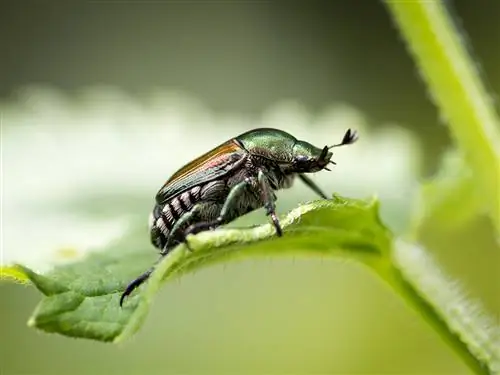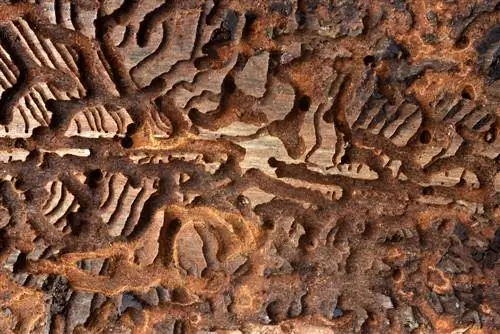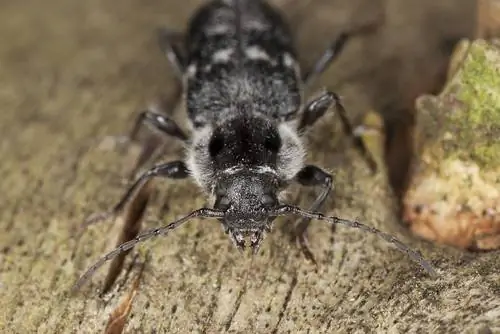- Author admin [email protected].
- Public 2023-12-16 16:46.
- Last modified 2025-06-01 06:02.
The Japanese beetle is considered a voracious insect and feeds on more than 300 different plants, including fruit trees and vines. In order to report sightings, it is important to be able to distinguish the beetle from native insects such as the May beetle.
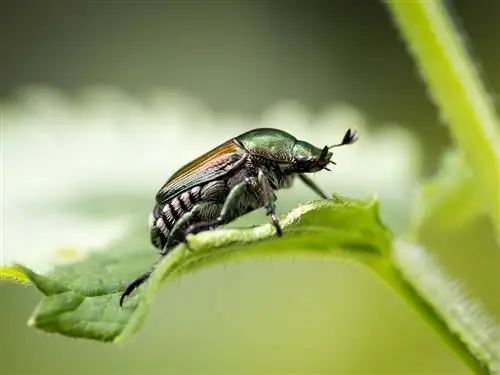
How to fight the Japanese beetle?
The Japanese beetle is an invasive insect that attacks over 300 different plants, including fruit trees and grape vines. Natural methods are recommended for combating it, such as nematodes, pheromone traps, pathogenic fungi and encouraging predators such as birds and hedgehogs. In Germany, discoveries of the beetle must be reported.
What is a Japanese beetle?
The Japanese beetle is a beetle that comes from Japan and is introduced through imports. It is considered an invasive species and feeds on the leaves and roots of more than 300 native host plants. The beetle has been spotted twice in Germany since 2014 and has not yet posed any danger. It is fought with the help of pheromone traps or fungal spores.
Life cycle of the Japanese beetle
The life cycle of the Japanese beetle begins with laying eggs at a depth of about ten centimeters below the top layer of soil. Visually, these are barely visible due to their white color and size of just 1.5 millimeters. After about two weeks, the larvae, also known as grubs, hatch from their eggs and begin feeding on the surrounding plant roots.

Over the winter months, the grubs retreat deeper into the ground to hibernate. When outside temperatures rise again in spring, the larvae pupate. Four to six weeks later, the Japanese beetles emerge from their shells and move to the surface of the earth. From there the insects' mating season begins. During this time the beetles feed on leaves, flowers and fruits. When the females lay their eggs after 30 to 45 days, the cycle begins again.
The grubs can be recognized externally by the followingcharacteristics:
- whitish body
- brownish headboard
- one pair of legs on each of the front three chest segments
- Abdominal segments are leg-free
- hairs on the stomach side run in a V-shape towards the anal area
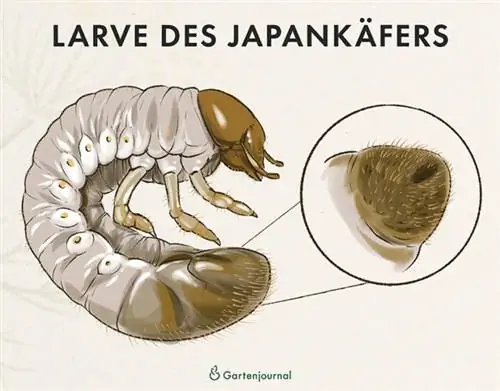
Danger of confusion - recognizing and differentiating Japanese beetles
Due to their limited distribution in this country, the Japanese beetle is often confused with other native insect species in practice.
Characteristics of an adult Japanese beetle
An adult Japanese beetle can be distinguished from other beetle species by three distinctive features:
Spots: The Japanese beetle has two tufts of hair on the last abdominal segment that are visible as white dots. In addition, each side of the abdomen is decorated with five additional tufts of white hair that run below the wings.
Color: The insect's wings shine in a shiny copper tone while the head has a greenish glow.
Size: The adult Japanese beetle is between eight and twelve millimeters in size.
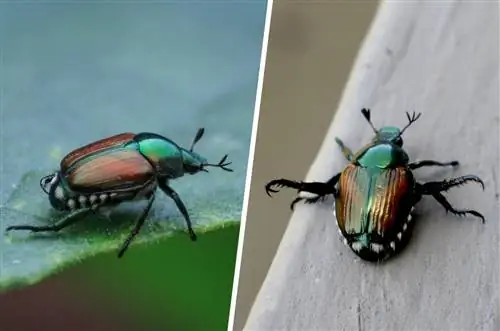
Left: The tufts of hair are the main characteristics of the Japanese beetle, Right: When in danger, the beetle stretches its legs away
Tip
In contrast to many other beetles that run away when threatened, the Japanese beetle behaves differently. When threatened, the insect remainsmotionlessin place andalso spreads its legs away from the body. The exact background of the observed behavior has not yet been fully researched.
Native beetles compared to the Japanese beetle
In this country we are particularly familiar with the ground beetle, the cockchafer and also the June beetle, which at first glance can easily be confused with the Japanese beetle.

Japan beetle
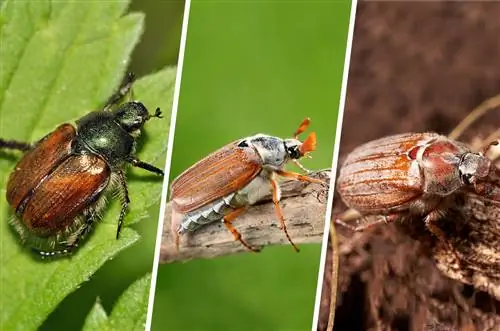
Garden leaf beetles, cockchafers and June beetles
Garden leaf beetle: With a body size of 0.8 to 1.1 centimeters, the garden leaf beetle is one of the rather small insects. The basic color of the body is a mix of black and green, which also has a metallic sheen and consistent hair. The wings are light brown in color and have longitudinal stripes.
Cockchafer: The cockchafer is about 2.5 to 3 centimeters in size. It can also be recognized by its black basic color in combination with a reddish-brown pattern on the wings. The sides of the body also have a white zigzag pattern. Hairiness can only be found on the abdomen.
June beetle: The June beetle is significantly smaller compared to its namesake the May beetle, measuring 1.3 to 1.8 centimeters. In terms of color, this is characterized by a consistently light brown color and hair, which is not interrupted by patterns or other markings.
Japanese beetles in Germany
The Japanese beetle has not yet arrived widely in Germany. Nevertheless,scattered discoveries also occur in this country. To date, the spread has been assumed to be due to anthropogenic introduction. The individual insects travel as stowaways in transport vehicles to the respective locations.
Dissemination
The Japanese beetle has only appeared very rarelyin Germany as well as in the immediate neighboring countries of Austria and Switzerland.

The first confirmed case in Germany dates back to May 30, 2014, when a local occurrence was identified in Paderborn-Sennelager (source: Patrick Urban). In November 2021, the second confirmed case occurred in Germany, namely in Freiburg. The male Japanese beetle discovered was in a pheromone trap near the freight station (source: baden-wuerttemberg.de). Two confirmed cases occurred in Switzerland in both 2017 and 2021. While the Japanese beetle was discovered in southern Ticino on the border with Italy in 2017 (source: forstpraxis.de), the second specimen was found in a pheromone trap in Basel in August 2021 (source: landwirtschaft-bw.de).
Is the Japanese beetle poisonous?
Despite the great fuss that has arisen around the isolated finds of the Japanese beetle, the insects poseno danger to people or other animals. Despite its powerful mouthparts, it is unable to penetrate the skin. In addition, the Japanese beetle does not contain any toxic substances that could cause skin irritation or other symptoms.
What does the Japanese beetle eat?
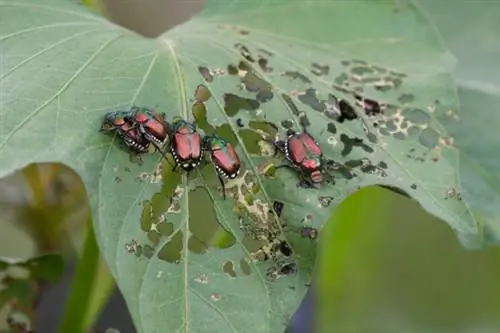
The Japanese beetle is extremely unspecific in its choice of food and has now been found on over 300 different host plants. The most frequently affected plants includewoody plants, fruit trees and arable cropsExamples includegrape vines, raspberry and blackberry plants, but also apple trees and beech trees. While the grubs feed exclusively on the roots, the adult beetles primarily attack the tops of the leaves above ground. In the event of a severe infestation that is not combated in a timely manner, there is a risk of baldness and thus the death of the entire plant.
Host plants in Germany
The Japanese beetle cases confirmed in Germany have so far fortunately turned out to be isolated cases that have not led to any lasting damage to nature. Taking into account the large number of potential host plants, a delayed discovery of a pair of Japanese beetles already leads to uncontrolled reproduction of the insects. In addition to the host plants already mentioned, Japanese beetles also attackvegetable plants, soft fruits and green areasKnown cases can be traced back totomato, bean, raspberry and strawberry plants. Ornamental plants and trees were rarely visited in the past.
Damage
Root: During their growth, the subterranean larvae feed on the root shoots of the host plant. These are eaten down to the rootstock by the grubs, so that the plant can no longer supply itself with sufficient moisture and nutrients.
Flowers, leaves and fruits: The adult Japanese beetles primarily attack the parts of the plants above ground and feed on both the leaves and the flowers and fruits of the host plant. Due to their invasive nature, several insects can usually be found on one plant. The affected plant parts are eaten down to the veins.
Fighting Japanese beetles
To avoid uncontrolled spread, the Japanese beetle should be combated as soon as it is discovered. Chemical control is fundamentally not recommended - there are some natural means of control available.
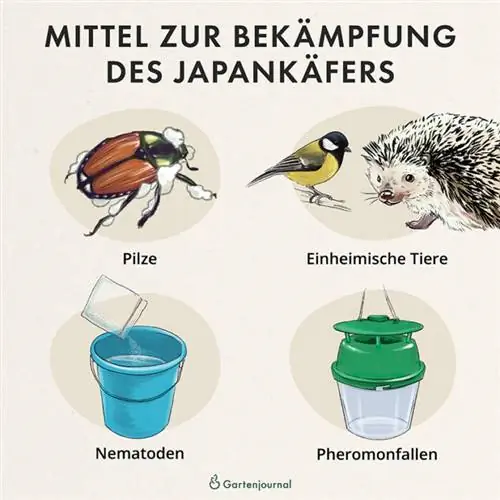
Natural control
To protect nature and especially other insects, a Japanese beetle infestation should be combated using natural means if possible.
Nematodes: The nematodes, also known as roundworms, are a well-known beneficial insect for controlling underground larvae. The extremely aggressive worms attack the grubs as parasites and turn them into their hosts. However, the nematodes have no access to the adult beetles.
Pheromones: Pheromones are chemical messengers that can be used to attract various animal species. Sexual pheronomes are used in particular for this purpose. Due to their high willingness to mate after pupation, adult Japanese beetles can be easily captured using pheromone traps. However, the fragrances have no effect on the larvae.
Mushrooms: Pathogenic molds are particularly suitable for combating pests, as they infect the insects and thus lead to their death. However, these pathogens must be introduced into the environment in large numbers. For this purpose, above-ground plant parts are usually prepared with appropriate pathogens and then presented to the Japanese beetles as food.
Predators: In addition to the native bird species, the natural predators of the Japanese beetle also include ground beetles, shrews, hedgehogs and moles. The provision of species-specific breeding and nesting aids promotes the settlement of the original enemies and also protects the ecosystem.
Tip
In addition to the means mentioned, you can also collect the beetles by hand with a bowl full of water. The beetles can be served as food to chickens, for example.
Chemical insecticides
The use of chemical insecticides should be carefully considered before use, as in most cases they have a generalist effect on almost all insect species. By spreading the products, not only unwanted pests are affected, but also many beneficial insects such as bees and butterflies. According to current studies, there areno approved chemical agents against the Japanese beetle, so their use should be avoided.
Report Japanese beetles
The Japanese beetle has been classified as a priority quarantine pest due to its high damage rates abroad. When discovered, these must be reported immediately to the responsibleplant protection service of the individual federal state. You can find an overview of all relevant positions here. The employees on duty will then provide you with additional information on how to proceed after your report.
Scientific works and studies
Due to the high level of damage in other parts of the world, the Japanese beetle is becoming increasingly important in this country, so that various scientific works and studies on the behavior and lifestyle of the beetle are being developed and published. A small selection of the most famous treatises can be found below.
More information
The scientific work by Peter Baufeld and Ruth Schaarschmidt from 2020 deals with the life cycle of the Japanese beetle and the effects on plant he alth.
The structured profile of Gitta Schrader, Melanie Camilleri, Ramona Mihaela Ciubotaru, Makrina Diakaki and Sybren Vos from 2019 represents the basis for the quarantine harmful organisms that are assessed annually by the plant protection services. The risk potential is particularly important in this context, but also the possibility of detecting and identifying the insects plays a crucial role.
Finds
Paderborn-Sennelager: The discovery of a Japanese beetle in Paderborn-Sennelager in 2014 represents the first confirmed evidence of the insect's presence in Germany orCentral Europe. Patrick Urban deals with the astonishing discovery in his 2018 paper.
Combat
Pheromones: The article by John H. Loughrin, Daniel A. Potter and Thomas R. Hamilton-Kemp from 1995 is one of the first scientific papers on the Japanese beetle. Using several series of tests, connections could be established between the accumulation of hordes of beetles and phenylpropanoid compounds that are produced when leaves decompose. This thesis was developed in 2000 by J.-Y. Kim and W. S. Leal, who also found a significantly higher sensitivity in male Japanese beetles.
Nematodes: The report by Yi Wang, Randy Gaugler and Liwanf Cui from 1994 was primarily concerned with the effect of different nematode species on the host body of the Japanese beetle. In addition to the mortality rate, the nematode reproduction rate was also examined in detail.
Fungi: The work by Michael G. Klein and Lawrence A. Lacey from 2010 deals with a series of studies in which adult Japanese beetles come into contact with the fungus Metarhizium anisopliae were brought.
Investigations by researcher Sostizzo, which appeared in the Observer magazine in 2021, relate to the infection of Japanese beetle larvae. Unlike their adult relatives, these are significantly less susceptible to the aggressive pathogens, so that ever stronger spores are used under quarantine conditions.
Lorena Barra, Andres Iglesias and Carlos Pino Torres already discovered in 2019 that fungal spores are among the most sustainable pesticides. In addition to its easy propagation, the researchers were particularly impressed by its uncomplicated use on large areas.
Chemical control and parasitic wasps: In addition to natural control methods, there is also increasing research into chemical agents that are suitable for use against the Japanese beetle. However, H. Drees' findings from 1953 do not provide any insight into an effective chemical agent. Essentially, this is due to the high diversification of host plants, which makes uniform treatment almost impossible. In contrast, the use of parasitic wasps has proven to be much more effective.
Ongoing Projects
IPM Popillia: The IPM Popillia project is particularly active in the area of research and development of adequate measures against the insect. In addition to the distribution routes, the drivers of population development are also examined and compared. In the next step, needs-based strategies for expulsion and killing will be developed from these findings and then tested in series of experiments. The focus of the work is on developing a holistic solution that includes both economic and ecological aspects.
FAQ
What damage does a Japanese beetle cause?
While the adult beetles primarily eat the above-ground plant parts down to the skeleton, the destruction of the roots by the larvae leads to a reduced ability to absorb fluids and nutrients.
Are Japanese beetles dangerous?
The Japanese beetle is not dangerous for humans or animals. Its mouthpart is too weak to injure the skin. In addition, the insect does not contain any toxic substances that could lead to symptoms of poisoning.
Where is the Japanese beetle reported?
The Japanese beetle must be reported to the responsible plant protection service in your federal state.
How is the Japanese beetle controlled?
The Japanese beetle can only be effectively controlled by natural means such as nematodes, pheromones, fungi or predators. The use of chemical agents has not yet proven successful in practice.
What does a Japanese beetle look like?
The Japanese beetle has a light brown to copper body color in combination with a greenish shimmering head part. Compared to other insects, there are two white tufts of hair on the abdomen, which are lined by five more on the sides.
What does the Japanese beetle eat?
The insect feeds on the leaves, fruits and flowers of around 300 different host plants, including fruit trees and vegetable plants.

